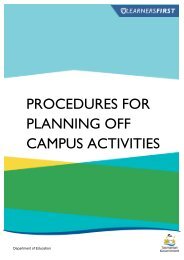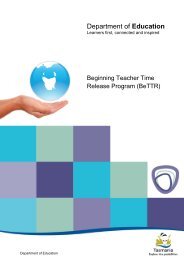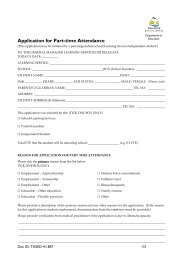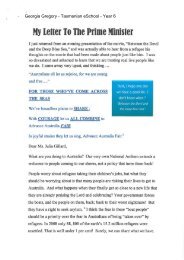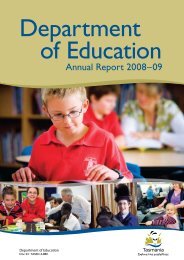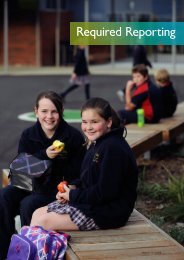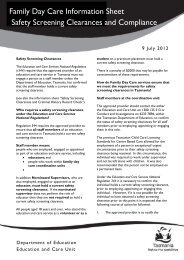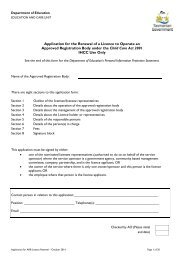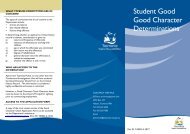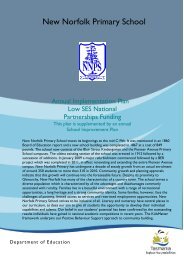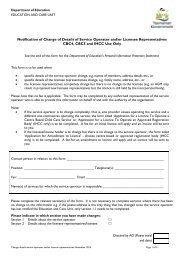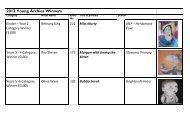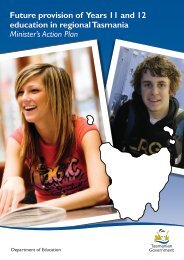Tas Curriculum K-10 - Languages - Italian - Department of Education
Tas Curriculum K-10 - Languages - Italian - Department of Education
Tas Curriculum K-10 - Languages - Italian - Department of Education
You also want an ePaper? Increase the reach of your titles
YUMPU automatically turns print PDFs into web optimized ePapers that Google loves.
Assessment indicators – alphabetic languages<br />
Communication<br />
Listening<br />
Speaking<br />
Reading<br />
Writing<br />
Standard five: Demonstrates comprehension <strong>of</strong> overall meaning and key supporting details in<br />
authentic and modified spoken texts<br />
Stage 13 Stage 14 Stage 15<br />
listens to a description, analyses the features and matches it to one <strong>of</strong> a set <strong>of</strong> images e.g. places,<br />
people, clothing<br />
listens to song lyrics and identifies key words and ideas<br />
listens to a set <strong>of</strong> instructions that requires things to be done in a certain order to achieve a<br />
result e.g. following directions in an environment, following a recipe<br />
listens to different points <strong>of</strong> view and summarises the ideas e.g. describing preferred food or<br />
restaurant; views on TV programs<br />
identifies ‘when’ something is happening e.g. in the past, future<br />
adapts to a range <strong>of</strong> speakers<br />
shows understanding <strong>of</strong> texts which incorporate prior learning<br />
infers meaning <strong>of</strong> some unknown words or expressions from context in extended aural texts<br />
Standard five: Coherently presents and requests information and opinions in sustained<br />
conversations and oral presentations<br />
Stage 13 Stage 14 Stage 15<br />
recites a text such as a poem, autobiography or song<br />
prepares and delivers a group presentation, using prompts<br />
draws on and adapts known language to answer questions or participate in a conversation<br />
interviews a peer / adult using contextually and culturally appropriate language<br />
surveys class members to make observations and classify preferences about youth issues<br />
self-corrects pronunciation and applies pronunciation patterns to unfamiliar language<br />
uses appropriate forms <strong>of</strong> politeness in different contexts<br />
reports back to the class to share results <strong>of</strong> a survey<br />
initiates interactions on familiar topics<br />
Standard five: Demonstrates comprehension <strong>of</strong> overall meaning and key supporting details in<br />
authentic and modified written texts<br />
Stage 13 Stage 14 Stage 15<br />
uses a range <strong>of</strong> strategies to infer meaning <strong>of</strong> unfamiliar words<br />
selects, orders and compares key information, opinions and relevant details e.g. on traditions,<br />
beliefs and values<br />
reads a text to locate information for a specific purpose, and synthesizes the information e.g.<br />
short biography / article<br />
presents a personal view on a text<br />
deciphers text messages and reconstructs the full message<br />
Standard five: Conveys a range <strong>of</strong> experiences or ideas, applying appropriate vocabulary and<br />
structures in a range <strong>of</strong> written texts<br />
Stage 13 Stage 14 Stage 15<br />
manipulates language to express own ideas and for different purposes e.g. compares information<br />
or ideas<br />
writes and responds to emails to establish and maintain contact with a peer studying the<br />
language in another school<br />
maintains a personal journal / diary<br />
uses a range <strong>of</strong> appropriate tenses<br />
writes up to 4 or 5 paragraphs across a broad range <strong>of</strong> text types e.g. letter, brochure, web<br />
page, email, description, creative story, report<br />
77



